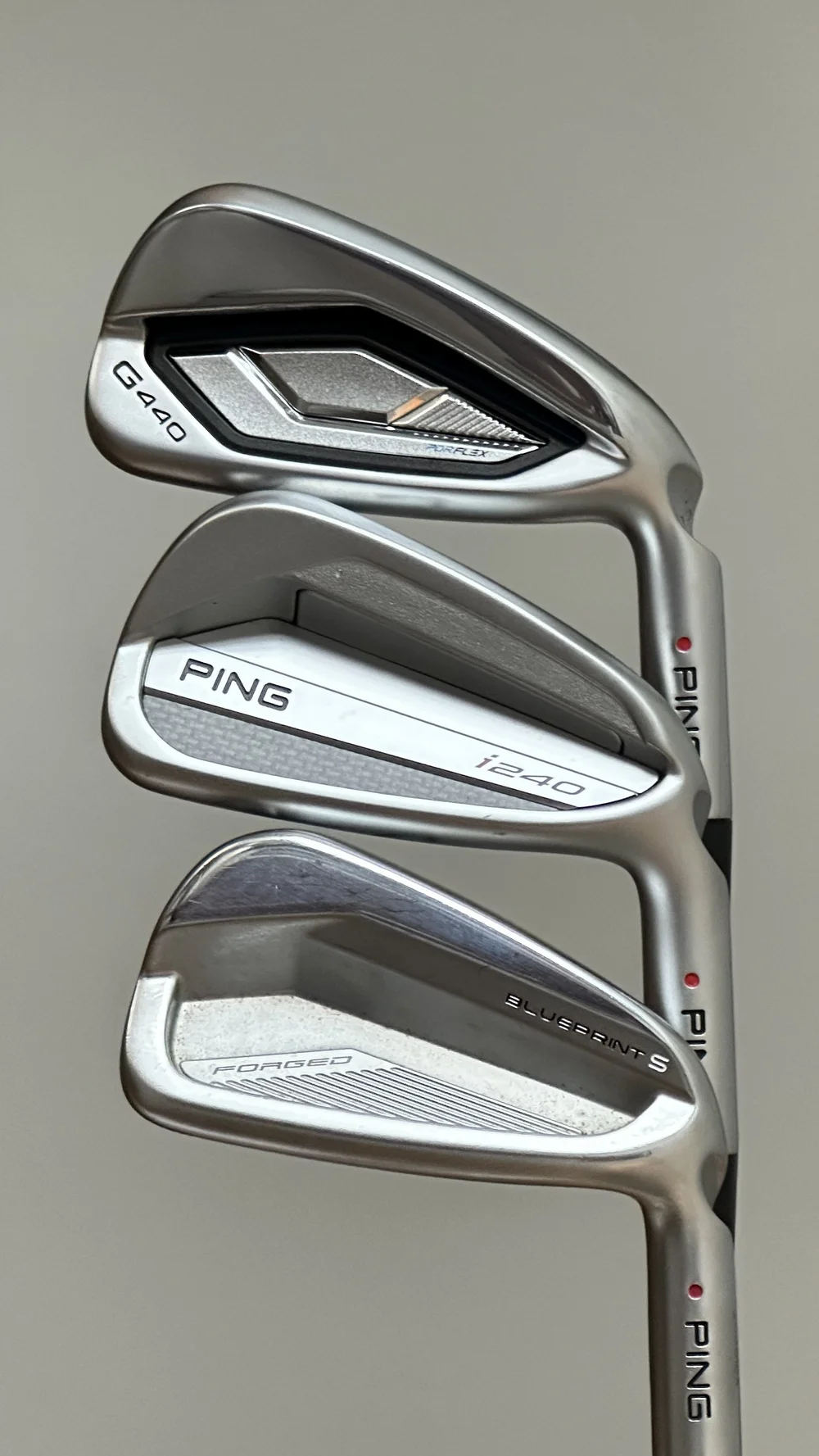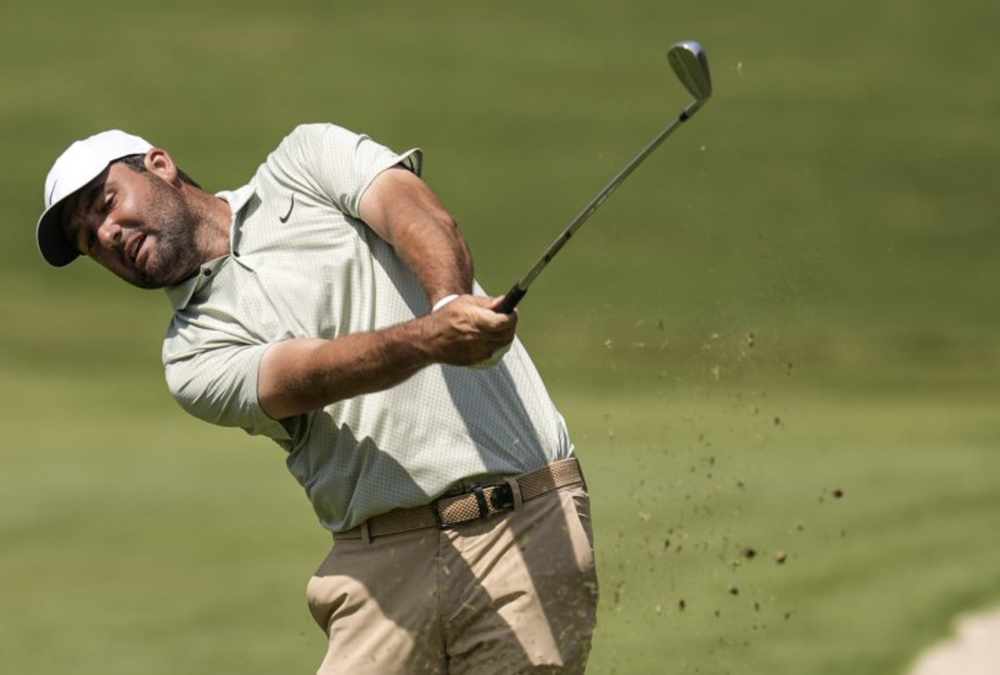Golf News
Golf Channel News
- Feed has no items.
Andrew Rice Golf Blog
- Which Iron is Right for You?by Andrew Rice on July 16, 2025 at 8:40 pm
All golfers are aware that there are different genres of irons available to them, yet many are not aware of what the actual differences might be. This article is designed to help you sift through some current offerings, give you insight into the differences in ball flight you might expect and thus make a selection that better suits your game. With this in mind I gathered three current models sent to me by my friends at PING: the new G440, the very new i240 and my current gamer, the Blueprint S. I used the 7i from each set and each club has the same shaft, grip, length, flex, swing weight and lie angle. This way the differences in ball flight can only be attributed strictly to the differences in the clubhead. While each of the 7 iron heads have standard lofts, the G440 has 29º of loft while the i240 and the Blueprint S each have 33º of loft. Yes, modern day, larger club head models have lowered lofts to aid in helping the ball fly further, but that lower loft is also in place to manage trajectory concerns. The “flex-face” technology increases ball speed, reduces spin and increases height. The decrease in loft serves a dual purpose of increasing distance and ball speed, but it also deters the ball from flying overly high. The test involved hitting 12 shots with each club in randomized three-ball increments. I used a very low tee for all shots in order to keep grass and debris from influencing the outcome. Once I had hit 12 shots with each club I culled the worst 4 shots with each club to eliminate any outliers that could corrupt the data. All the data was captured using TrackMan in normalized mode which keeps any temperature, altitude or wind effects out of the data. The blue shots were the Blueprint S, the red shots were the i240 and the purple shots were the G440. PING G440 Angle of Attack -6.1, Dynamic Loft 19.9º, Club Speed 83.6 mphSpin Rate 4956 rpm, Ball Speed 121.7 mph, Carry 177.2 yds, Peak Height 88.4 feet, Land Angle 44.5ºThe ball stopped 10.8 yards after landingPING i240Angle of Attack -6.2, Dynamic Loft 21.3º, Club Speed 84.3 mphSpin Rate 5637 rpm, Ball Speed 118.1 mph, Carry 167.1 yds, Peak Height 87.5 feet, Land Angle 45.7ºThe ball stopped 9.8 yards after landingPING Blueprint SAngle of Attack -6.1, Dynamic Loft 21.7º, Club Speed 83.5 mphSpin Rate 5710 rpm, Ball Speed 117.3 mph, Carry 165.4 yds, Peak Height 87.7 feet, Land Angle 45.9ºThe ball stopped 8.3 yards after landing What can we take away from this test?Any interesting note was that while the G440 had 4º less loft I only delivered the clubface with +/- 1.5º less loft relative to the i240 and the Blueprint S. The peak height was virtually identical with all three models. Modern day “face-flex” (my term) technology makes the ball fly further, with less spin and while the stopping power will be decreased, the gains in distance for those in need far outweigh any negative effects.In my professional opinion anybody who swings a 7 iron at 75 mph or faster does not need the distance help a “face-flex” iron provides. You currently hit the ball far enough to sacrifice the distance gains for improved predictability and stopping power.And that’s the big question: do you need more consistency and improved ability to stop the ball once it lands? Or is distance more important? Personally, I will be switching to the new i240 iron (5-UW). I like the look and feel of the clubhead and know that the slight bump in forgiveness from the Blueprint S model will serve me well.As you decide which direction to take before purchasing your next set of irons, please consider some of the information I have shared here. I hope this info helps you play your best and experience more joy out on the golf course.(Many thanks to Peter Egazarian and Farmington CC outside Charlottesville, VA for allowing me to teach and conduct my test.)
- All You Need to Get Longerby Andrew Rice on May 20, 2025 at 12:34 am
When it comes down to it there are only a few simple things we can do to get longer off the tee and it truly comes down to physics. We can either be more efficient with the speed that we currently possess or learn to move the clubhead faster through impact. The following video addresses both elements and goes into greater detail… We have the following important elements to tap into if we’d like to hit the ball longer off the tee, and yes, we all would…Improved EfficiencyImpact LocationUse a powder based spray like foot spray or dry shampoo to get the feedback you need regarding where you are striking the ball on the club face. Practice with the spray on a regular basis to improve your strike quality and energy transfer from clubhead speed into ball speed.Club DeliveryThis important element is a product of the direction the clubhead is traveling as it runs into the back of the golf ball. For maximum distance the ideal delivery occurs when the clubhead is traveling straight, which means it has very little in-to-out or out-to-in bias and slightly upward. I have found that the best attack angle range is somewhere between 2 and 5 degrees upward. Anything more than that will most likely compromise a player’s ability to strike the ball properly.Faster Club SpeedA Longer BackswingThe further you can make the handle travel going back, the more time you have to pump energy into the system. Make sure you do this one correctly as the arms need to remain fairly wide and extended for maximum handle travel in the backswing.Intentional PracticeWe must train our bodies to move faster and this is the best single way to educate your body and nervous system to move faster. You don’t need to overdo this, but a 20-25 ball set once a week will do wonders for your ability to get moving. And the best part, once you get faster, it’s very easy to maintain that increase in speed. You have the ability to make the ball travel around 2.75 yards per MPH of clubhead speed when at peak efficiency. If you’re still looking for more distance the only way to get there is to work towards an increase in speed. I hope this message inspires you to start putting the work in to hit the ball longer off the tee, because we are all better with a 9i in our hands than we are with a 7i in our hands. I have done it, and I know that with some motivation and a little effort, you can too.
- Everything You Need for Better Chippingby Andrew Rice on March 17, 2025 at 4:16 pm
Yes, I know I’ve posted many chipping videos over the last decade stating that this is exactly what you need for better results. I do, however, like to think that as an engaged and caring coach my information is evolving and improving as time passes. These three keys are CURRENTLY the best information I have ever been able to share with you. Please take a look… The three important areas are as follows:The Set UpMake sure that you are set up close to the golf ball at address with your toes in the vicinity of one foot from the ball. Feel the handle high and forward along with the thumbs being down and away from you. This should position the the heel of the club slightly off the ground at address.The BackswingKeep the clubhead over the target line as best you can throughout the back and forward swing. Try to avoid allowing the clubhead to get too far inside on either side of the ball. The more inside the clubhead gets in the backswing, the lower it stays and the lower the clubhead in the backswing, the more challenging a downward strike becomes.The Body MotionFeel like the upper body rocks/tilts towards the target in the backswing. This creates an environment whereby the body is ahead of the ball as the club starts down the strike is now more likely to be ball first and ground second.Please, please go out and give this a try. Trust me - you will not regret it.Thanks for reading! Set Up and Backswing
- How to Get Off the Back Footby Andrew Rice on November 5, 2024 at 12:36 pm
I know there are many golfers out there who struggle with staying on their back foot for too long. If you feel you have a hard time getting onto the front foot in the downswing then give this video a watch… If the club face is overly open throughout the swing we will often have a tendency to hang back as this aids in closing the face late in the downswing. Shifting onto the front side will actually SLOW the closing of the face and an open face in the downswing needs that process sped up. That’s why the first objective for any golfer that hangs back should be to strengthen the face in the downswing. Once you have a stronger club face on the way down you should take the Scottie Scheffler Shuffle Challenge. Work to get your pelvis driving forward enough to drag that trail foot at some point in the downswing. Have some fun with this one and if you happen to hit a few shanks as you work to do this – the club face is still too open. Give it a go.
- The REAL Reason We Need Shaft Leanby Andrew Rice on August 19, 2024 at 8:12 pm
When hitting shots with the ball on the ground it is simply imperative that we lean the shaft towards the target at impact in order to expose the sweet spot to the back of the golf ball. After watching this video you will know exactly why… As you can now see if you’re not leaning the shaft it isn’t possible to hit the ball out the center of the face. Leaning the shaft and delivering the clubhead in a slightly descending fashion gives us the best opportunity to compress the ball and deliver maximum energy transfer. A leaning shaft at impact gives us:a delofted club face, thus improving ball speed and distance.a sweet spot that can now collide with the golf ball.increased ability to hit down on the ball, thus improving strike quality.an energetic and penetrating ball flight that sizzles!I’m sure you’re wondering what you can do to start leaning the shaft more effectively for shots played off the ground. Keep in mind that an open face on the way down will corrupt any ability a player might have of leaning the shaft. Try these ideas:at address, feel that your hands are slightly ahead of the ball and that your weight gently favors the front foot.make sure your club face is in a neutral to strong position on the way down and into impact. Tip it down!practice hitting low, knockdown style shots on a regular basis. Punch the ball.Give these ideas a try to start to improve the quality of strike, ball flight, distance, feel and outcome of your shots off the ground. I sincerely hope it helps!





